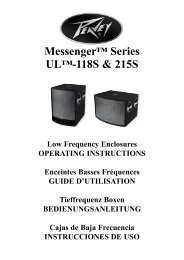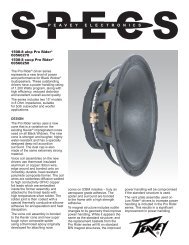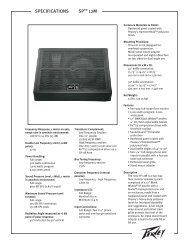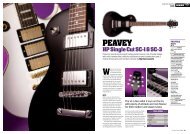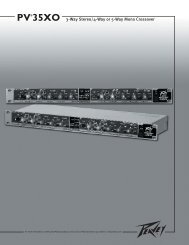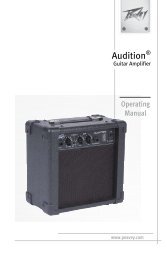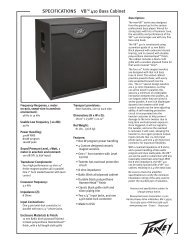Peavey ValveKing VK112 combo
Peavey ValveKing VK112 combo
Peavey ValveKing VK112 combo
You also want an ePaper? Increase the reach of your titles
YUMPU automatically turns print PDFs into web optimized ePapers that Google loves.
THE GUITAR PLAYER’S BIBLE<br />
<strong>Peavey</strong> <strong>ValveKing</strong><br />
<strong>VK112</strong> <strong>combo</strong>
PEAVEY VALVEKING <strong>VK112</strong> COMBO £349<br />
GUITAR AMPS<br />
The rivals<br />
Vox AC30CC 1 x 12 £649<br />
Randall RG50TC 1 x 12<br />
£499<br />
Marshall DSL 401 1 x 12<br />
<strong>combo</strong> £539<br />
Vox’s AC30 Custom<br />
Classic range has cool<br />
styling with some neat<br />
boutique features, but<br />
this Chinese-made<br />
AC30 is comparatively<br />
pricey and its somewhat<br />
narrow tonal range<br />
means it’s most likely<br />
to suit Vox enthusiasts.<br />
Randall’s RG50TC was<br />
a strong performer in<br />
our recent review and<br />
sounds superb – it’s<br />
easily capable of outclassing<br />
some amps<br />
that cost twice as much,<br />
however the <strong>ValveKing</strong>’s<br />
pricing means the<br />
Randall doesn’t look<br />
as good as it did in the<br />
value for money stakes.<br />
Marshall’s stalwart<br />
DSL401 has been the<br />
beginner’s first choice<br />
for many years, but is<br />
now looking decidedly<br />
tired and overpriced in<br />
this very competitive<br />
sector of the market. If<br />
you want the Marshall<br />
sound and badge then<br />
it won’t disappoint,<br />
but there’s a lot more<br />
choice now and the<br />
impact of Chinese-made<br />
pricing can’t be ignored<br />
PHOTOGRAPHY JOBY SESSIONS<br />
<strong>Peavey</strong> <strong>ValveKing</strong> <strong>VK112</strong> <strong>combo</strong> £349<br />
I<br />
t was only a matter of time before<br />
one of the major players in guitar<br />
amplification weighed in with a<br />
Chinese-made product and <strong>Peavey</strong>’s<br />
new <strong>ValveKing</strong> is the amp range that<br />
everyone’s been talking about.<br />
Combining cool boutique-inspired<br />
With features you won’t find on<br />
some models costing twice as<br />
much, <strong>Peavey</strong> hasn’t undercut<br />
the competition, it’s<br />
comprehensively blown it away<br />
<strong>Peavey</strong>’s awesome <strong>ValveKing</strong> range is great news for everyone –<br />
apart from other manufacturers, that is by Nick Guppy<br />
features with pricing that will make<br />
almost every other amp manufacturer<br />
wince, the <strong>ValveKing</strong> has generated<br />
more than interest. So, apart from the<br />
price tag, what’s all the fuss about?<br />
Let’s take a look at the <strong>ValveKing</strong><br />
<strong>VK112</strong> <strong>combo</strong> and find out.<br />
The <strong>ValveKing</strong> range is designed in<br />
Meridian, USA, but made offshore in<br />
China. As we’ve recently seen with<br />
other Chinese-made products, this is<br />
no longer something that should be<br />
viewed with disdain or doubt – yes it’s<br />
built to a price, but the standard of<br />
construction is still what we would<br />
expect from <strong>Peavey</strong>.<br />
The cabinet is neatly clad in tough<br />
black vinyl with metal corner<br />
protectors, and a smart silver check<br />
grille-cloth covers the <strong>ValveKing</strong>’s<br />
special 12-inch loudspeaker. The<br />
electronics are contained within a<br />
sturdy open-tray steel chassis on four<br />
printed circuit boards – one large PCB<br />
holding all the main preamp and power<br />
supply components, another for the<br />
<strong>VK112</strong>’s pair of 6L6 output valves and<br />
12AX7 driver, with two smaller boards<br />
for mains and rear panel connections.<br />
These boards aren’t through-plated,<br />
but they’re robust and well-supported<br />
on metal standoffs – internal wiring is<br />
minimal and neatly routed, while the<br />
valve bases are all chassis mounted,<br />
which makes replacement easier. At<br />
this price it’s a good standard of<br />
construction that inspires confidence.<br />
The <strong>ValveKing</strong>’s front panel is easy to<br />
navigate. There’s a pair of high and low<br />
sensitivity input sockets feeding two<br />
channels with separate three-band<br />
EQs. Next to the clean channel’s single<br />
volume control are a pair of<br />
PEAVEY <strong>VK112</strong> COMBO TEST RESULTS<br />
Build quality<br />
Features<br />
Sound<br />
Value for money<br />
■ WE LIKED Great range of sounds;<br />
unbelievably low price; texture control adds<br />
considerable versatility<br />
■ WE DISLIKED A little over-gained for<br />
some; reverb could do with some taming<br />
pushbutton switches for toggling the<br />
amp’s bright function and changing<br />
channels, while another pair of buttons<br />
next to the overdrive channel’s gain<br />
control operate preset distortion and<br />
volume boost functions that can be<br />
used separately or together as<br />
required. The front panel tour finishes<br />
with a pair of jacks for the series effects<br />
loop and a master level control for the<br />
short Belton reverb spring.<br />
However, the <strong>ValveKing</strong>’s real secret<br />
weapon is around the back in the shape<br />
of a knob <strong>Peavey</strong> calls the texture<br />
control. This is a new patent-pending<br />
feature that simultaneously varies the<br />
power stage’s sensitivity, response and<br />
‘break-up’ point. With the texture<br />
control set fully clockwise, the<br />
<strong>ValveKing</strong> is working in normal pushpull<br />
Class A/B operation. Then as you<br />
rotate the control anti-clockwise, one<br />
half of the output stage is progressively<br />
subtracted from the circuit, while the<br />
driver valve’s gain is increased and its<br />
The <strong>ValveKing</strong>’s<br />
speaker is a special<br />
design 1 x 12<br />
low frequency response altered to<br />
complement the change from odd to<br />
even-order harmonic emphasis. At<br />
fully anti-clockwise, the <strong>ValveKing</strong><br />
effectively transforms from push-pull<br />
class A/B to single-ended Class A, with<br />
around 60 per cent less output power<br />
and a completely different character.<br />
This clever feature can be fine-tuned<br />
with a resonance switch that varies low<br />
frequency response by altering the<br />
amp’s damping factor. The rear panel is<br />
also home to a handy extension<br />
speaker jack and a socket for the<br />
footswitch, which changes channels
PEAVEY VALVEKING <strong>VK112</strong> COMBO £349<br />
GUITAR AMPS<br />
The footswitch<br />
changes channels and<br />
toggles the volume/<br />
distortion boost<br />
PEAVEY VALVEKING<br />
<strong>VK112</strong> COMBO<br />
PRICE: £349<br />
ORIGIN: USA designed,<br />
Chinese built<br />
TYPE: All valve twochannel<br />
Class A/AB<br />
<strong>combo</strong> with solid-state<br />
rectification<br />
OUTPUT: Variable from<br />
approx 30-50W RMS<br />
VALVES: Three ECC83/<br />
12AX7, two 6L6 power<br />
amp<br />
DIMENSIONS: 460 (h)<br />
x 540 (w) x 260mm (d)<br />
WEIGHT (kg/lb): 21/44<br />
CABINET: MDF with ply<br />
baffle<br />
LOUDSPEAKER: One<br />
12-inch <strong>Peavey</strong><br />
<strong>ValveKing</strong> special design<br />
CHANNELS: Two<br />
CONTROLS: Clean<br />
channel: volume, bass<br />
mid, treble. Overdrive<br />
channel: gain, volume,<br />
bass, mid, treble, master<br />
reverb level.<br />
FOOTSWITCH: Twobutton<br />
footswitch<br />
changes channels,<br />
toggles preset volume/<br />
distortion boost function<br />
on overdrive channel<br />
ADDITIONAL<br />
FEATURES: Bright<br />
switch, footswitchable<br />
volume and boost presets<br />
for overdrive channel,<br />
series effects loop,<br />
texture control (varies<br />
power stage from Class<br />
A/B push-pull to Class A<br />
single ended), tight/loose<br />
resonance control,<br />
extension speaker jack<br />
(disconnects internal<br />
driver)<br />
OPTIONS: None<br />
RANGE OPTIONS: The<br />
100-watt <strong>ValveKing</strong><br />
VK212 <strong>combo</strong> also<br />
includes variable<br />
resonance and presence<br />
controls for just £449,<br />
while you can have the<br />
<strong>ValveKing</strong> VK100 head<br />
for just £349 with a<br />
matching VK412 cabinet<br />
for £249 – that’s a 100W<br />
half stack for under<br />
£600.<br />
<strong>Peavey</strong> Electronics<br />
01536 461234<br />
www.peavey.com<br />
and activates or defeats the boost<br />
functions preset on the front panel.<br />
SOUNDS: Switched on, the <strong>ValveKing</strong><br />
is quiet and hum-free – always a good<br />
sign. The clean channel has a warm,<br />
rounded character that’s especially<br />
friendly to single-coil guitars – we got<br />
the best results with all three tone<br />
controls set around the halfway mark.<br />
The bright switch really works, so if<br />
your axe has mid-range-heavy<br />
humbuckers you’ll approve of the extra<br />
twang this feature injects. Push the<br />
clean channel’s volume control beyond<br />
the halfway mark,<br />
add a little reverb<br />
and you’ll get a<br />
smooth overdrive<br />
that’s good for blues<br />
or country soloing<br />
and easily controlled<br />
from the guitar. Back<br />
off a little and it<br />
cleans up nicely for<br />
chords, or push it up<br />
for lead breaks.<br />
Distortion fiends won’t be<br />
disappointed with the <strong>ValveKing</strong>’s<br />
USA-flavoured overdrive channel.<br />
Even without using the boost feature<br />
there’s a ton of filth on tap, while<br />
engaging it will take even the weediest<br />
of pickups into almost endless sustain.<br />
Some players may even find this<br />
channel slightly over-gained. It’s still<br />
great fun to play unaccompanied with<br />
extreme distortion, however, in a live<br />
band context there’s some loss of<br />
The texture control is<br />
very powerful and at gig<br />
levels it makes a profound<br />
difference to the way the<br />
<strong>ValveKing</strong> responds – you<br />
can really hear the<br />
change in headroom<br />
definition with the controls maxed out.<br />
But apart from a few very expensive<br />
exceptions, almost all ultra-high gain<br />
valve amps do this and it’s one reason<br />
why many metal players use solid-state<br />
for their overdrive requirements.<br />
It doesn’t detract from the great<br />
sounds that can be pulled from the<br />
<strong>ValveKing</strong> using more realistic control<br />
settings. We actually found the best<br />
results with the gain level set to around<br />
4. At this low-ish setting the <strong>ValveKing</strong><br />
is still far from restrained, with plenty<br />
of bite and sustain to satisfy for ripping<br />
blues or rock solos, while the boost and<br />
volume presets add<br />
the versatility of a<br />
three-channel set-up<br />
without any of the<br />
complication. You<br />
can use the<br />
unboosted sound as<br />
a powerful crunch<br />
channel, then hit the<br />
footswitch for extra<br />
distortion, volume or<br />
both to punch your<br />
solos through the mix. The texture<br />
control is very powerful and at gig<br />
levels it makes a profound difference to<br />
the way the <strong>ValveKing</strong> responds – you<br />
can really hear the change in headroom<br />
as the knob is turned, along with the<br />
shift in character from class A/B bold<br />
and punchy to thick and compressed<br />
Class A. Combine this with the<br />
resonance control and you’ve got a lot<br />
of tone that stays useful from almost<br />
bedroom level up to indecently loud –<br />
easily enough to cope with small to<br />
medium no-PA gigs.<br />
The reverb level’s range is more than<br />
most people will need and, while it<br />
tended to get a little splashy at higher<br />
settings on both channels, at around<br />
one quarter it adds a nice halo to single<br />
notes and chords.<br />
Verdict<br />
The <strong>ValveKing</strong> is a great design from<br />
<strong>Peavey</strong> with some unique features that<br />
not only set it apart from the crowd but<br />
also make it an amp that new players<br />
won’t quickly outgrow. Experienced<br />
players and professionals should also<br />
make a point of checking this amp out:<br />
it’s solidly built, versatile and quick to<br />
dial in, and the low noise threshold<br />
makes it equally handy in the studio,<br />
where the Class A end of the texture<br />
control’s range can be used to get<br />
blistering hot overdrive at fairly<br />
painless volume levels. And, if any<br />
more persuasion were needed, there’s<br />
the price. At just under £350 for this<br />
1 x 12 <strong>combo</strong> version, <strong>Peavey</strong> hasn’t<br />
undercut the competition, it’s<br />
comprehensively blown it away.<br />
Remember, this is an all-valve amp with<br />
features you won’t find on some models<br />
costing twice as much. It’s brilliant<br />
value for money and, for the moment at<br />
least, we reckon the <strong>ValveKing</strong> is easily<br />
the best entry level valve amp money<br />
can buy.<br />
<strong>Peavey</strong> <strong>ValveKing</strong> <strong>VK112</strong><br />
RATING<br />
Fans of distortion<br />
will certainly not be<br />
disappointed with<br />
the <strong>ValveKing</strong>’s<br />
overdrive channel




